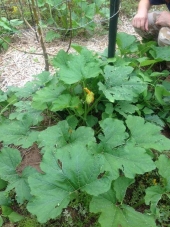
 14
14




sow…reap…compost…repeat
 8
8




 4
4




We have had some success with blue corn on the highest, driest, most exposed part of our property ... planted in early July right as the monsoons started.
Rabbitbrush and snakeweed are two plants they see as indicating prime areas
sow…reap…compost…repeat
 11
11




 9
9




I also did a test this time and these seeds amazingly germinated at a depth of 8”. I’m going to plant up to 10-12” next time and see if that helps with better rooting and plant stability. I had a lot fall over from the heavy rains and winds.
sow…reap…compost…repeat
 3
3




 3
3




1) is easy, I'll try that... but how important is 2)? With bog standard corn, do i just plant more in the hole to get more chance of success, or can i go halves on the method going maybe 4 or 6 inches deep rather than 8 or 12?
sow…reap…compost…repeat
 2
2




 4
4




Amy Gardener wrote:
Healthy sagebrush and four-wing salt bush were also identified as potentially promising locations. Washes and places with signs of run-off collecting from nearby slopes indicate greater moisture under the soil surface. Looking for signs of water awakens my senses and cultivates my own roots in this desert.
 6
6




 2
2




 2
2




Skyler Weber wrote:I am not ready to give up because the idea of water-free corn is too awesome to let go. But, I want to try different seed. Has anyone had good (or mediocre) results and can you post the links of where you go the seed?
 9
9





Increasing Crop Productivity, Soil Quality, Water Absorption & Retention in the Absence of Irrigation
https://coragarden.com/hopi-dryland-corn-2024.php
 10
10





Increasing Crop Productivity, Soil Quality, Water Absorption & Retention in the Absence of Irrigation
https://coragarden.com/hopi-dryland-corn-2024.php
 5
5




I'm only 65! That's not to old to learn to be a permie, right?
 11
11




Thom Bri wrote:
Skyler Weber wrote:I am not ready to give up because the idea of water-free corn is too awesome to let go. But, I want to try different seed. Has anyone had good (or mediocre) results and can you post the links of where you go the seed?
I guess that means not good results? This year was unusually hot and dry. Next year is predicted, due to El Nino, to be wetter. Might help.
Best suggestion I can make is to try to find locally grown seeds.
Also, I am skeptical that the natives of that region NEVER watered their corn. I bet they carried water by hand to get the seeds started.
 9
9




 7
7




Fish Farley wrote:
" The favored planting location is an “ak-chin” field, an area on the alluvial fan where the water spreads out at the mouth of the wash. Hopi can identify the soil’s capacity for moisture below by the kind and quantity of natural vegetation growing on the surface.
“The weeds will tell,” says Michael Kotutwa Johnson (Hopi). For instance, land adjacent to fields dominated by rabbitbrush indicates abundant soil moisture. Johnson and University of Arizona educator Lisa Falk co-curated an exhibition about “The Resiliency of Hopi Agriculture” that is on display at the Arizona State Museum—a Smithsonian Affiliate— through January 2020.
...
 6
6




Our inability to change everything should not stop us from changing what we can.
 3
3




Invasive plants are Earth's way of insisting we notice her medicines. Stephen Herrod Buhner
Everyone learns what works by learning what doesn't work. Stephen Herrod Buhner






 7
7




I'm only 65! That's not to old to learn to be a permie, right?
 9
9




Okay, Amy How did this turn out in 2022?
sow…reap…compost…repeat
 8
8




 6
6




Josh Warfield wrote:
Next year, I'm going to try building mounds with a hole in the middle, putting seeds in the bottom of the hole, and then covering them with pure sand so there won't be an adobe brick between the seeds and the surface.
 1
1




 2
2




Invasive plants are Earth's way of insisting we notice her medicines. Stephen Herrod Buhner
Everyone learns what works by learning what doesn't work. Stephen Herrod Buhner

|
Been there. Done that. Went back for more. But this time, I took this tiny ad with me:
The new purple deck of permaculture playing cards
https://www.kickstarter.com/projects/paulwheaton/garden-cards
|








